Slime molds - Study guides, Class notes & Summaries
Looking for the best study guides, study notes and summaries about Slime molds? On this page you'll find 213 study documents about Slime molds.
Page 3 out of 213 results
Sort by
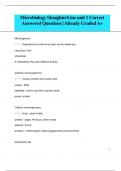
-
Microbiology StraighterLine unit 1 Correct Answered Questions| Already Graded A+
- Exam (elaborations) • 15 pages • 2024
- Available in package deal
-
- $12.19
- + learn more
Microorganism : Organisms too small to be seen by the naked eye Less than 1mm Unicellular If multicellular thay lack different tissues acellular microorganisms : viruses -protein and nucleic acid, viroids - RNA satellites -nucleic acid with a protein shell prions- protein Cellular microorganisms : fungi - yeast molds protists - algae, Protozoa, slime molds bacteria -E Coli archaea - methanogens (natural gas)extreme environments prokaryotic cell 2 : cell that does not have a nuc...

-
UH MANOA BIO172 EXAM 1 Questions with Complete Correct Answers | Grade A+
- Exam (elaborations) • 17 pages • 2024
- Available in package deal
-
- $10.49
- + learn more
Ans: A) possess two flagella. 3. Which process in Paramecium results in genetic recombination but no increase in population size? A) budding B) meiotic division C) conjugation D) binary fission Ans: C) conjugation 4. Green algae differ from land plants in that many green algae A) are unicellular. B) have chloroplasts. C) have alternation of generations. D) have cell walls containing cellulose. Ans: A) are unicellular. 5. Super cells characteristic of plasmodial slime molds result ...

-
MICROBIOLOGY EXAM 1 WITH COMPLETE SOLUTIONS 100%
- Exam (elaborations) • 14 pages • 2023
- Available in package deal
-
- $13.49
- + learn more
MICROBIOLOGY EXAM 1 WITH COMPLETE SOLUTIONS 100% microbiology - correct answer study of microscopic organisms bacteria - correct answer simple, single cell bacteriology fungi - correct answer single and multi cell forms yeast (single cell), filamentous molds, complex fungi (mushrooms) mycology protists - correct answer single cell, some mutlicellular algae, protozoans (amoebas), slime molds protozoology viruses - correct answer acellular, intracellular parasites virology ...

-
Turf Pest Control 3B Kansas Questions and Answers Rated A+
- Exam (elaborations) • 48 pages • 2024
- Available in package deal
-
- $11.49
- + learn more
Turf Pest Control 3B Kansas Questions and Answers Rated A+ Turfgrass industry in Kansas includes: home lawns, institutional and industrial grounds, sod production, golf courses, athletic fields and other recreational turf, parks, roadsides, airports, and cemeteries. Turf management involves selecting: the right grass, proper mowing, watering, fertilizing, and controlling thatch. Geographically, Kansas is is in the transition zone between the northern cool-season grass range and t...
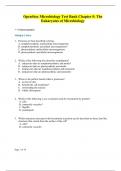
-
OpenStax Microbiology Test Bank Chapter 5: The Eukaryotes of Microbiology
- Exam (elaborations) • 14 pages • 2024
-
Available in package deal
-
- $20.00
- + learn more
OpenStax Microbiology Test Bank Chapter 5: The Eukaryotes of Microbiology * = Correct answer Multiple Choice 1. Protozoa are best described as being: A. nonphotosynthetic multicellular microorganisms B. nonphotosynthetic unicellular microorganisms* C. photosynthetic multicellular microorganisms D. photosynthetic unicellular microorganisms 2. Which of the following best describes zooplankton? A. eukaryotes that are nonphotosynthetic and motile* B. eukaryotes that are photosynthet...

-
Clemson Microbiology 3050 Exam 1 with verified solutions.
- Exam (elaborations) • 16 pages • 2024
-
- $14.49
- + learn more
Microorganism Organisms and acellular entities too small to be seen clearly by an unaided eye; =<1mm in diameter often unicellular Cellular Fungi (yeasts + molds) protists (algae, protozoa, slime molds) bacteria (E. coli) Archaea (methanogens) Brainpower Read More Previous Play Next Rewind 10 seconds Move forward 10 seconds Unmute 0:00 / 0:15 Full screen Acellular Viruses (protein + nucleic acids) Viroids (RNA) Satellites (Nucleic Acid + RNA) Prions (inf...

-
BIO 102: Exam 2 Questions With Correct Answers!!
- Exam (elaborations) • 18 pages • 2024
- Available in package deal
-
- $7.99
- + learn more
Most protists are _________, but there are some that are ____________________ - unicellular; multicellular How did the nucleus form? - invagination invagination - plasma membrane folds in on itself and inner compartments (organelles) are formed the job of the nucleus - - protect DNA - control what goes in and out of the nucleus endoplasmic reticulum - an organelle coming off of the nucleus where proteins are made golgi apparatus - newly synthesized proteins are given some final processin...
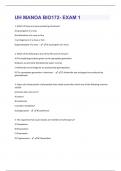
-
UH MANOA BIO172- EXAM 1 (LATEST) QUESTIONS WITH SOLVED ANSWERS 100% CORRECT!!
- Exam (elaborations) • 10 pages • 2024
- Available in package deal
-
- $7.99
- + learn more
1. Which of these are spore-producing structures? A) sporanguim of a moss B) antheridium of a moss or fern C) archegonium of a moss or fern D) gametophyte of a moss - A) sporanguim of a moss 2. Which of the following is true of the life cycle of mosses? A) The haploid generation grows on the sporophyte generation. B) Spores are primarily distributed by water currents. C) Antheridia and archegonia are produced by gametophytes. D) The sporophyte generation is dominant. - C) Antheridia and...
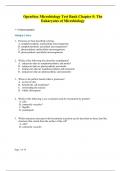
-
OpenStax Microbiology Test Bank Chapter 5: The Eukaryotes of Microbiology
- Exam (elaborations) • 14 pages • 2024
-
- $17.09
- + learn more
OpenStax Microbiology Test Bank Chapter 5: The Eukaryotes of Microbiology * = Correct answer Multiple Choice 1. Protozoa are best described as being: A. nonphotosynthetic multicellular microorganisms B. nonphotosynthetic unicellular microorganisms* C. photosynthetic multicellular microorganisms D. photosynthetic unicellular microorganisms 2. Which of the following best describes zooplankton? A. eukaryotes that are nonphotosynthetic and motile* B. eukaryotes that are photosynthet...
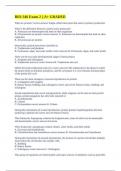
-
BIO-346 Exam 2 || A+ GRADED
- Exam (elaborations) • 5 pages • 2024
-
- $10.99
- + learn more
What are protists? correct answers Single-celled eukaryotes that assist in primary production What is the difference between a protist and a protozoan? A. Protozoan are heterotrophs that feed on other organisms B. All protozoan are protists correct answers A. Protozoan are heterotrophs that feed on other organisms B. All protozoan are protists Historically, protists have been classified as: A. Trophozoites and plankton B. Protozoans, algae, and water molds correct answers B. Protozoan...

Do you wonder why so many students wear nice clothes, have money to spare and enjoy tons of free time? Well, they sell on Stuvia! Imagine your study notes being downloaded a dozen times for $15 each. Every. Single. Day. Discover all about earning on Stuvia


